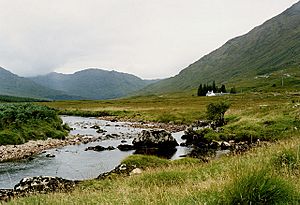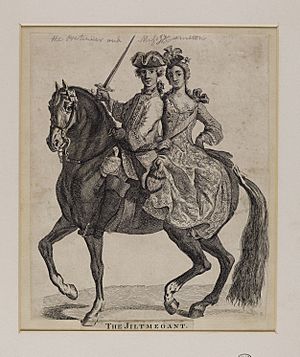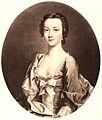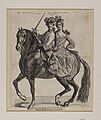Jean Cameron of Glendessary facts for kids
Quick facts for kids
Jean Cameron of Glendessary
|
|
|---|---|
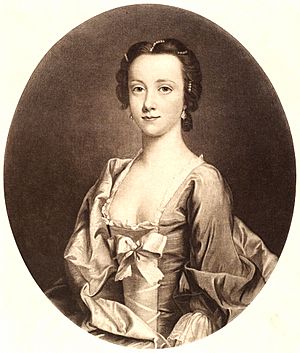
Portrait, traditionally identified as Jean Cameron, by Allan Ramsay
|
|
| Born | c.1698 |
| Died | 27 June 1772 |
| Burial place | Blacklaw, East Kilbride |
| Nationality | Scottish |
| Other names | Jenny Cameron |
| Known for | Claimed to be the mistress of Charles Edward Stuart |
| Parent(s) | Allan Cameron, 3rd of Glendessary Lady Christian Cameron |
| Relatives | Donald Cameron of Lochiel (cousin) |
Jean Cameron of Glendessary (born around 1698 – died 1772) was a Scottish noblewoman. She was a Jacobite, meaning she supported the Stuart family's claim to the British throne. Jean Cameron became famous for her supposed role in the Jacobite rising of 1745. This was a time when Charles Edward Stuart, also known as Bonnie Prince Charlie, tried to win back the throne for his father. She was often called Jenny Cameron or Bonnie Jeanie Cameron. Many exciting, but often untrue, stories about her made her a Jacobite hero.
Contents
Jean Cameron's Early Life
Jean Cameron was the daughter of Allan Cameron of Glendessary. Her father had also been involved in an earlier Jacobite uprising in 1715. Her family, the Camerons of Glendessary, were a smaller part of the larger Clan Cameron. This clan was led by the Cameron of Lochiel chiefs.
Jean's mother, Christian Cameron, was also from the main Cameron of Lochiel family. Jean had two brothers, John and Allan. We don't know much about her early life. It is said she married an Irish army officer named O'Neill. After he died, she returned to Scotland.
Her brother John had a disability, so Jean often helped manage their family's land. In 1744, her brothers went abroad. Jean then became the "factor" (manager) of their estates. Her family held their land from the clan chief. This meant they had to gather their tenants for military service if the chief asked. So, when Donald Cameron of Lochiel decided to support Prince Charles Stuart in 1745, Jean's family had to join too.
The 1745 Jacobite Rising
Jean Cameron was reportedly at Glenfinnan on August 19, 1745. This was the day Prince Charles raised his flag to start the rebellion. Because she was managing her family's lands, she might have brought some of the Cameron fighters from Morvern. Her cousin, Alexander Cameron, was also there. Later, she visited the Jacobite court in Edinburgh. However, she did not play a big part in the actual fighting.
A man named Aeneas MacDonald, who was at Glenfinnan, described her. He said she was a widow, almost 50 years old. He called her a "genteel, well-looked handsome woman" with "pretty eyes" and "hair as black as jet." He also said she was "very sprightly" and "agreeable in conversation." He noted that she left with other observers as soon as the army marched. This suggests she did not join the army on its journey.
Stories About Jean Cameron and Prince Charles
Even though Jean Cameron probably didn't do much fighting, many untrue stories about her were spread. These stories were often "cruel and made-up." Some even showed her as a strong military leader, like an "amazon," marching at the front of her men. Other stories claimed she had a very close relationship with Prince Charles.
These tales were likely propaganda from the British government. They wanted to make the Jacobite cause look bad. They suggested that Jacobite leaders were weak or dishonest. These stories became very popular. They led to songs, books, and even a play about "Jenny Cameron." By 1750, she was a legend. However, these stories also damaged Jean Cameron's real reputation.
The truth about her involvement became even more confusing. In 1746, a woman named Jean or Jenny Cameron was captured by the government army in Stirling. People thought she was Jean Cameron of Glendessary. But the captured woman said she was actually a milliner (someone who makes hats) from Edinburgh.
Life After the Rebellion
After the Jacobite rising failed in 1746, the Cameron tenants in Morvern faced harsh actions from government soldiers. But Jean's family seemed to keep most of their property. Jean herself went back to a quiet life.
In 1751, she bought some quiet lands called Rodinghead and Blacklaw in Lanarkshire. This area is near what is now St Leonards, East Kilbride. People say she lived a peaceful and religious life at Blacklaw. She was well-liked by the local people. Even though she was Catholic, she gave money to support the local Presbyterian school.
A writer from the late 1700s described her as still having "striking remains of a graceful beauty." He also said she seemed "rather melancholy" but was smart and good at conversation. He noted that "politics was her favourite topic." In the 1830s, an old local resident remembered that "very many poor Highlanders were in the habit of visiting her."
Jean Cameron died in 1772. She was buried on her Blacklaw estate, near her house. Her house later became known as "Mount Cameron." The poet John Struthers later wrote about the "dark firs" around her "lowly" grave. By 1793, her grave was said to be "distinguished by nothing but a turf of grass." In the 20th century, her estate became a golf course. Her house was torn down in 1958. However, a horse chestnut tree was planted near her grave, and a plaque was put up in the same year.
Images for kids


